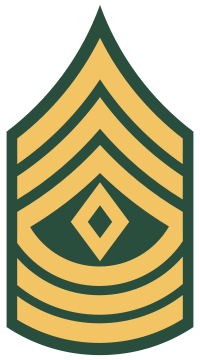|
Army First SergeantE-8 Noncommissioned Officer, U.S. Army |
|
Army Ranks » First Sergeant Rank • 1SG Pay • 1SG Rank History • Promotion Information
 History of the Army First Sergeant Rank
History of the Army First Sergeant Rank
A First Sergeant is a Noncommissioned Officer in the United States Army at DoD paygrade E-8.
The rank of First Sergeant traces its origins back to the colonial era, before America won its freedom from Britain.
In the Continental Army, there were four sergeants assigned to each company of soldiers. When the Continental Congress authorized a “fifth sergeant†for each company, the sergeants were stratified according to their expertise, with the most senior one by experience and demonstrated competency known as the “First Sergeant.â€
This manner of identifying the senior NCO in a company without award of a separate rank stood until 1847, the Congress authorized the grade and rank of First Sergeant as separate from other non-commissioned officer ranks in the Army. It is at this time also that there came about the distinctive insignia—perhaps the most feared but still respected among soldiers more junior to it—of three chevrons over three rockers with a diamond in the center.
With the creation of the rank of Technical Sergeant from a multitude of other NCO ranks following WWI, the rank of First Sergeant became equal in grade to that of Technical Sergeant yet different to it in terms of duties and responsibilities discharged.
As noted above, the rank of Master Sergeant was also borne of this reorganization in 1920, but at the time it stood above the rank of First Sergeant.
In 1942, the rank of First Sergeant was elevated one grade, making it equal to that of Master Sergeants. First Sergeants were considered junior Master Sergeants and the former were given the responsibility of the being the most senior-ranking NCO’s at the company level, charged with keeping good order and discipline in such units as well as providing guidance and leadership based on their experience and demonstrated competency.
Since Master Sergeants worked at higher level units, such as Battalions or Brigades, they were at this time considered more experienced than First Sergeants.
In 1958, the grade of E-8 was established by the Army and occupied by both First Sergeants and Master Sergeants.
From this point forward, soldiers promoted to E-8 took on the rank of Master Sergeant until they proved themselves worthy, by staff work at higher level units, for the responsibilities of a First Sergeant at the company level.
Thus, it is from this change that First Sergeants came to be considered more experienced and competent than Master Sergeants. Although they still share the same grade in modern times, First Sergeants are more respected and addressed by their full title, while Master Sergeants are addressed simply as Sergeant.
Additionally, time in grade while serving as a First Sergeant is unofficially required for promotion to the next grade and rank of Sergeant Major.
Want to learn more? Read about the Army's First Sergeant rank on Military-Ranks.org.
History of the Army
The Army is the oldest and most senior among the branches. The Army's heritage is traced back to the Revolutionary War, when each State of the Union had its own Army, lended to the command of General George Washington. Almost 250 years have passed, but the organizational structure and naming is largely the same. The Army is still divided into Divisions, Brigades, Regiments, Battalions, Companies, and Platoons.







































































































































